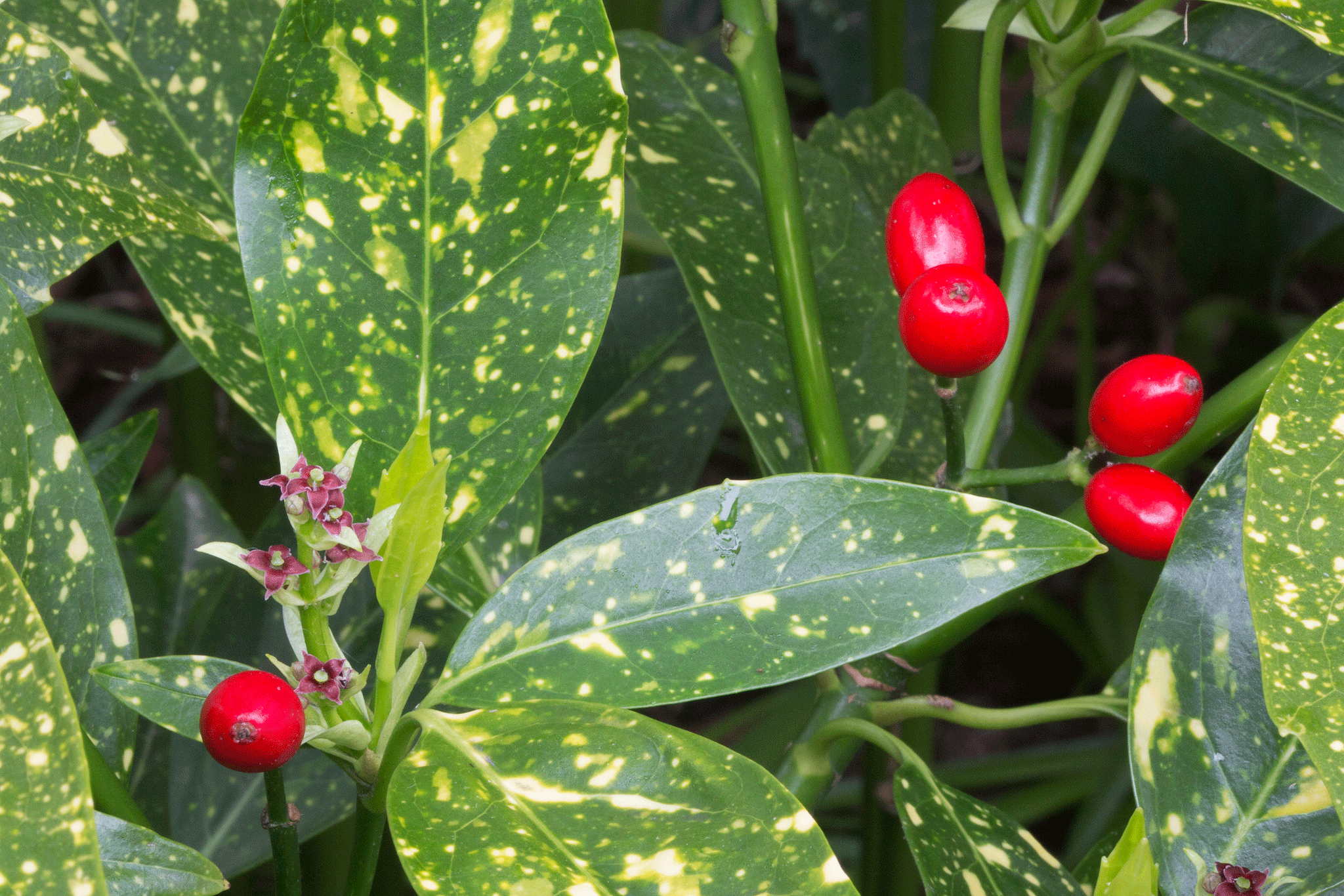Reliable evergreen for foliage and fruits
Bold and resilient evergreen shrubs reaching to 10 ft. (3 m) in height, with some dwarf cultivars. The large, glossy, deep green leaves are up to 8 in. (20 cm) long and vary from broadly oval to long and narrow; they may be splashed with yellow, speckled with gold, or both some heavily, others more delicately. On female plants, the small, unremarkable spring flowers are followed by clusters of bright red berries, but a nearby male plant is needed to ensure fruiting. Always buy a named cultivar to be sure of getting the male or female you need. Confusingly, both male and female forms may be found under some older names; it takes only one slapdash nursery to assume that because the foliage looks the same, the plants are the same. The self-fertile ‘Rozannie’ is probably the best choice for smaller sites, but this too fruits more prolifically with the presence of a male plant.
Height 10 ft. (3 m)
Hardiness Z6
When a plant is recognized as both attractive and dependable, it becomes widely planted. Such are the whims of gardeners that, after a spell in the spotlight, this very ubiquity sparks disdain. Hence the fate of the spotted laurel.
First introduced into the west from Japan as long ago as 1783, it was indeed a spotted form, Aucuba japonica ‘Variegata’, that was the first to be widely grown. It received an award—a First Class Certificate, no less—from the Royal Horticultural Society in 1865. ‘Variegata’, ‘Grandis’, with large plain green leaves, and the more slender-leaved ‘Lancifolia’, became staple plantings for many decades before the tide turned. Declared “boring” by gardeners, until recently aucubas were being torn out of shrub borders, mixed borders, informal hedges, windbreaks, and soundscreens. But it was no accident that in dry shady places they outlasted their neighbors. Rather than being scorned, they should have been admired and, fortunately, gardeners are once again starting to recognize the value of these shrubs.
All forms are excellent dry shade plants for zone 6 and above. In the darkest and driest sites, those with broad, plain green leaves will be more successful than those with narrow, heavily speckled or variegated foliage. Fortunately, aucubas provide enough variety in foliage form and pattern, and even in fruit color, that larger dry shade gardens can benefit from more than one cultivar.
Use spotted laurel along boundaries as a background to smaller shrubs, perennials, and bulbs; they are also ideal shrubs to soften corners in urban gardens. They make fine large foundation plants for the north side of the house, and even in dry shade are sufficiently dense to buffer noise from roads and neighbors. Display their foliage and fruits in large arrangements; they will outlast any flowers paired with them.
Aucuba japónica ‘Crotonifolia’ Large leaves with bold gold spots and blotches; one of the most colorful of all aucubas.
Aucuba japonica ‘Fructo-albo’ Dark leaves thinly speckled in pale green and gold; cream-colored fruits.
Aucuba japonica ‘Gold Dust’ The most brightly speckled female form. Red berries.
Aucuba japonica ‘Pepper Pot’ Relatively compact, with small, even, distinct spots.
Aucuba japonica ‘Picturata’ Each leaf features a bright yellow central splash with speckles around the edge.
Aucuba japonica ‘Rozannie’ Broad, deep green leaves on a slow-growing plant. Self-fertile, but even more large red fruits are produced with the presence of a male plant.
Aucuba japonica ‘Salicifolia’ Slender, bright green leaves on blue-green stems; generous with its red fruits.
Aucuba japonica ‘Seven Hills’ Slow-growing, very hardy form with red berries.
Aucuba japonica ‘Variegata’ The original speckled form now outclassed by ‘Gold Dust’.


